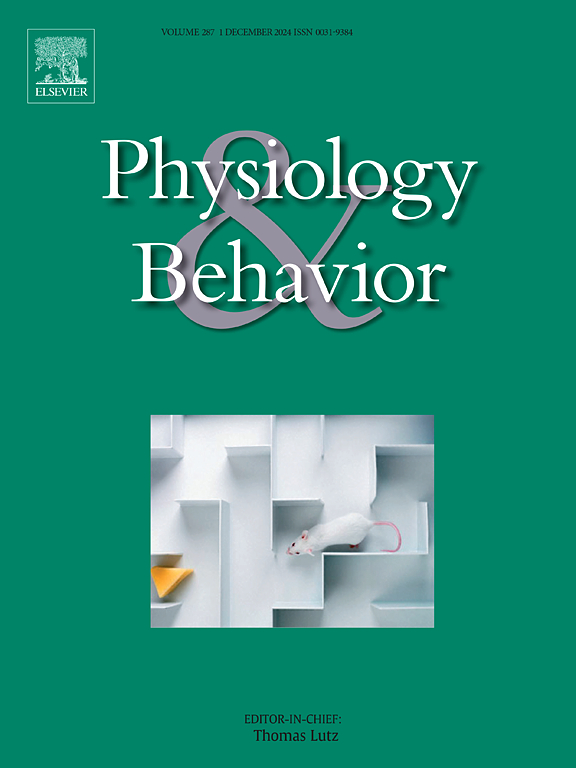Metabolomics changes after exercise intervention reveal potential peripheral biomarkers in repeated methamphetamine exposure
IF 2.5
3区 医学
Q2 BEHAVIORAL SCIENCES
引用次数: 0
Abstract
Methamphetamine (MA) use disorder has become a global public health problem, and the peripheral mechanisms underlying exercise as a potential treatment for MA addiction are still not fully understood. This study aims to identify a plasma metabolic biomarker in MA-administered mice under exercise interventions. The peripheral plasma metabolic profiles of C57BL/6 J mice were quantified by ultra-high-performance liquid chromatography and tandem mass spectrometry metabolomics methods. The mice were randomized into saline control (C), MA model control (NE-MA) and MA model exercise intervention (E-MA) groups, and a conditioned place preference paradigm was used to assess drug reward. Anxiety-like behavior and cognitive behavior was evaluated using the open field and Y-maze tests. A total of 35 differential metabolites effectively distinguished between NE-MA and C groups. These metabolites are mainly involved in membrane lipid, energy, and amino acid metabolism. Compared with the NE-MA group, the expression of five reward-related metabolites in the E-MA group was reversed: l-tryptophan, niacinamide, uridine, 2′-deoxyuridine, and uric acid, which are involved in amino acid, energy, purine, and pyrimidine metabolism. Upregulation in uric acid and l-tryptophan levels was associated with improved anxiety-like behavior and cognitive function after exercise intervention. These metabolites may serve as markers of exercise intervention in MA addiction and deserve further study.
运动干预后的代谢组学变化揭示了反复暴露于甲基苯丙胺中潜在的外周生物标志物
甲基苯丙胺(MA)使用障碍已成为一个全球性的公共卫生问题,而运动作为一种潜在的治疗MA成瘾的外围机制仍未完全了解。本研究旨在确定运动干预下ma给药小鼠的血浆代谢生物标志物。采用超高效液相色谱和串联质谱代谢组学方法对C57BL/6 J小鼠外周血代谢谱进行定量分析。将小鼠随机分为生理盐水对照组(C)、MA模型对照组(NE-MA)和MA模型运动干预组(E-MA),采用条件位置偏好范式评估药物奖励。采用开放场和y型迷宫测试评估焦虑样行为和认知行为。共有35种差异代谢物可有效区分NE-MA和C组。这些代谢物主要参与膜脂代谢、能量代谢和氨基酸代谢。与NE-MA组相比,E-MA组中参与氨基酸、能量、嘌呤和嘧啶代谢的l-色氨酸、烟酰胺、尿嘧啶、2′-脱氧尿嘧啶和尿酸这5种与奖励相关的代谢物的表达被逆转。尿酸和l-色氨酸水平的上调与运动干预后焦虑样行为和认知功能的改善有关。这些代谢物可能作为运动干预MA成瘾的标志物,值得进一步研究。
本文章由计算机程序翻译,如有差异,请以英文原文为准。
求助全文
约1分钟内获得全文
求助全文
来源期刊

Physiology & Behavior
医学-行为科学
CiteScore
5.70
自引率
3.40%
发文量
274
审稿时长
47 days
期刊介绍:
Physiology & Behavior is aimed at the causal physiological mechanisms of behavior and its modulation by environmental factors. The journal invites original reports in the broad area of behavioral and cognitive neuroscience, in which at least one variable is physiological and the primary emphasis and theoretical context are behavioral. The range of subjects includes behavioral neuroendocrinology, psychoneuroimmunology, learning and memory, ingestion, social behavior, and studies related to the mechanisms of psychopathology. Contemporary reviews and theoretical articles are welcomed and the Editors invite such proposals from interested authors.
 求助内容:
求助内容: 应助结果提醒方式:
应助结果提醒方式:


